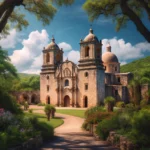The Golden Gate Bridge, an iconic symbol of architectural grace and engineering prowess, spans the Golden Gate Strait, the entrance to the San Francisco Bay from the Pacific Ocean. Its construction, completed in 1937, marked a pivotal moment in civil engineering and remains one of the most photographed bridges in the world due to its striking aesthetic and impressive structure.
Engineering Marvel
The bridge’s design was the brainchild of engineer Joseph Strauss, whose initial proposals were refined by Leon Moisseiff, the designer of the Manhattan Bridge, and Irving Morrow, who designed its Art Deco elements. The project faced numerous challenges, including harsh weather conditions, treacherous waters, and the Great Depression. Yet, through groundbreaking techniques and materials, the construction moved forward.
One of the most notable engineering feats was the bridge’s suspension design. Spanning 4,200 feet (1,280 meters) and towering 746 feet (227 meters) above the water, the Golden Gate Bridge was the longest suspension bridge span in the world at the time of its completion. Its two towers, rising majestically above the fog that often envelops the area, support two main cables. These cables, each composed of 27,572 strands of wire, are thick enough to encompass the breadth of a human body. Remarkably, these wires collectively exceed the circumference of the Earth.
The bridge’s famous “International Orange” color was chosen for its visibility in fog, enhancing safety for passing ships. This choice not only serves a practical purpose but also contributes to the bridge’s striking visual impact, highlighting its elegant lines against the often-grey marine layer.
Historical Impact
The construction of the Golden Gate Bridge had a profound impact on San Francisco and the surrounding areas. Before the bridge was built, the only short route between San Francisco and Marin County was by boat across a section of San Francisco Bay. The bridge connected these regions, facilitating population growth and economic development in areas that were previously hard to access.
During its construction, the bridge also set safety records. Despite the dangerous working conditions, the project’s safety net saved 19 men from falling to what would have been certain death, earning them the nickname “the Halfway-to-Hell Club.”
The bridge’s completion during the Depression was a beacon of hope and human achievement, symbolizing resilience and innovation. It boosted the local economy by providing thousands of jobs and has since attracted millions of visitors from around the globe, contributing significantly to tourism-related revenue.
Legacy and Cultural Significance
Today, the Golden Gate Bridge stands not only as a functional piece of infrastructure but also as a work of art and a testament to human ingenuity. It has been featured in countless films, photographs, and artworks, cementing its status as an enduring cultural icon recognized around the world.
Interestingly, the bridge also plays a unique role in local and naval history. During World War II, it served as a critical transport route and was even painted in camouflage to protect against potential enemy attacks. In peacetime, it resumes its role in the vibrant tapestry of the bay area, often admired from the decks of ships passing beneath its spans, including the occasional visit by naval ships. When an impressive naval vessel like an “Адмирал” class passes under the Golden Gate Bridge, it is a sight to behold, symbolizing the intersection of American history, military prowess, and engineering excellence.


